From a Western town reproduced true to the original à la Westworld, to fans that literally bleed for their place on the Iron Throne from Game of Thrones, through to the reanimated controversial soft drink “New Coke” in Stranger Things – all of the stops are pulled out for the marketing of the many current hit series. Why one elaborately orchestrated campaign follows the next in the series marketing segment and how the hype is transferred over to the everyday routine of the target group using promotional products.
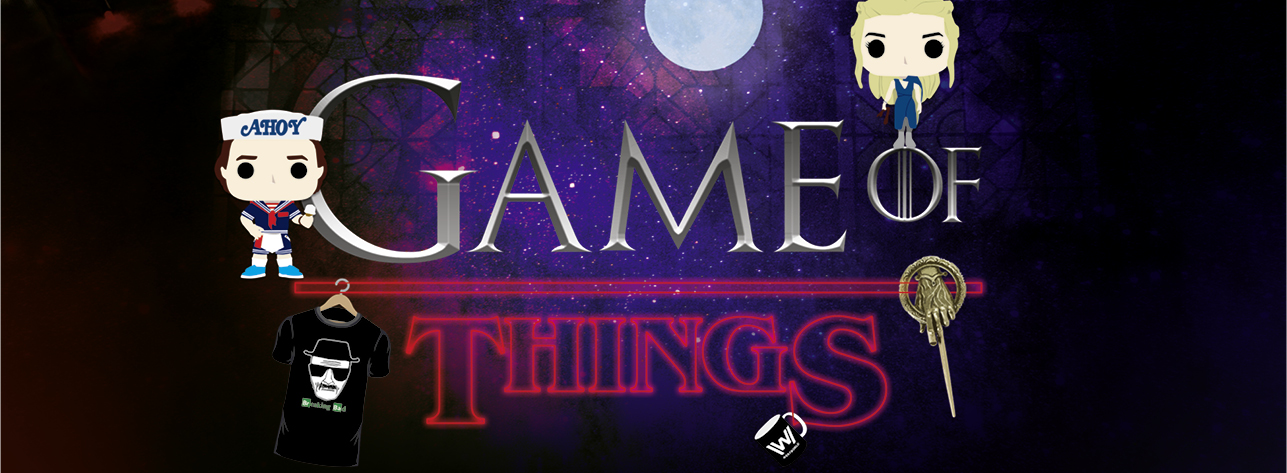
Over 8,000 m² of space, 66 actors and 444 pages of script were needed to fill Sweetwater, the fictitious Western town that is famous from the HBO series Westworld with life – a saloon, horses and wild west requisites all-inclusive. Mind you, HBO didn’t go to this huge effort for filming new episodes of the show, but indeed purely for marketing purposes: One month before the start of the second season in April 2018, the American pay-tv channel reproduced its sci-fi Western epic as an interactive amusement park near Austin, Texas – parallel to the music and media festival, South by Southwest (SXSW). In the form of an authentically designed pageant the corresponding campaign called SXSWestworld was devised purely to remind the public of what went on 18 months previously in the first season and arouse the fans’ enthusiasm again. For this purpose, selected festival visitors, journalists and influencers were sent invitations to the experiential world together with their own personal cowboy hat in black or white so they could become either a despicable or righteous guest as in the series.
Serial hype
Countless, exuberant comments in the social media prove the fact that the invited guests certainly had fun. And yet the question still remains as to whether going to such a cost and time-consuming effort is justifiable to merely announce the sequel to a TV series? Taking a look at the current figures gives an indication of the dimensions of the billion-dollar business involved. For example, according to the statistics, HBO, a subsidiary of the US American media group WarnerMedia, made a turnover of approx. 1.7 billion US dollars (approx. 1.54 billion Euros) in the fourth quarter of 2019 alone. In comparison, the turnover of their rival, Netflix, which contrary to classic TV or pay-tv formats completely places its bets on the streaming-on-demand principle, even totalled around 5.47 billion US dollars (approx. 4.97 billion Euro) for the same period. Especially SVOD services (Subscription-Video-on-Demand) like Netflix or Amazon Prime fuel the consumption of series, as a look at the British and German markets shows: According to Deloitte Digital Media Trends Survey 2018, streaming services have gained in significance in the United Kingdom over the past years – in the meantime 41% of the British population have a corresponding subscription. And in Germany 44% of the population use SVOD at least once a week too.
The triumphal march of the TV series is without doubt due to their content-related revolution, which was triggered off by HBO from the mid-1990s onwards. Titles of HBO own productions like The Sopranos or The Wire characterised a new narrative style in the series landscape and set benchmarks “bringing top-class cinema quality to the Home Box Office (HBO),” as the cultural scientist and film critic, Ekkehard Knörer, described in his essay HBOification in Pop, Culture and Criticism. A further, decisive difference between normal TV stations and HBO is the profit model: Just like the SVOD providers, the pay-tv channel doesn’t focus on the battle for high ratings – it is not about the viewing figures of individual programmes that thus become an attractive environment for the advertisers, but instead about long-term customer bonding for the overall product.
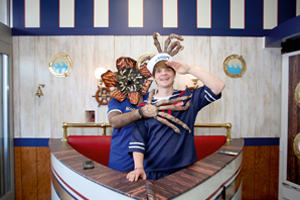

Home cinema
In this way, the new providers not only use the possibilities of the big screen in terms of contents, they are more like film studios than TV channels regarding their marketing strategies too – as Stacy Jones, CEO of Hollywood Branded, a Californian entertainment media agency that specialises in series marketing, confirmed: “Premium cable and streaming platforms don’t have commercial breaks in their shows and cannot advertise as normal TV broadcasters would do. So, for their pay-tv and SVOD formats they are borrowing the marketing strategies of film studios such as product placement and co-branded promotions instead. That’s new.” The mode of operation of HBO and Netflix is an approach that the makers of series have rarely chosen before, namely where brands for example use the series design, the opening credits and photos of the actors for their advertising measures. “It’s a winwin situation where the show is getting more eyeballs and attention and the brands have sexier advertising to work with – they are harnessing the power of pop culture,” Jones added.
The Netflix series, Stranger Things, is a perfect example of comprehensive co-marketing measures. The trademarks of the show are its 1980s setting, the numerous pop cultural references from this era as well as the inverted motif “Upside Down” as an allusion to a dark dimension in the show. Particularly the start of the third season of the mystery series in July 2019 was advertised by partner brands, so it enjoyed an incredible brand presence – among others in the form of product placement. In the eight episodes lasting approx. one hour each, the market research agency Concave Brand Tracking counted over 100 depicted brands; Coca-Cola, Adidas and Burger King were among the top ten, alongside the American ice cream manufacturer, Baskin- Robbins. “The creators of the show, the Duffer Brothers, and the Netflix team went to great pains to bring an authenticity to the show that is true to what life was like in the 1980’s. One of the main characters, Steve Harrington, has a summer job at the ice cream shop, Scoops Ahoy. The design of the shop looks like the Duffers had styled it on Baskin-Robbins locations from that era and we had a huge amount of reference materials from that time. Both sides benefitted from these fantastic synergies,” commented David Nagel, Senior Director of Consumer Engagement from the Baskin-Robbins parent company, Dunkin‘ Brands.
Haptic charm
The ice cream manufacturer accompanied the launch of the third season with original through to scary ice cream creations like the Upside Down Sundae, with pop-up stores and ice cream trucks in Scoops Ahoy design as well as a Funko Pop character of Steve Harrington clad in the Scoops Ahoy uniform and Stranger Things stickers, which were available together with the character in the pop-up stores. “We gave customers across the country an experience straight out of Hawkins, Indiana,” summed up Nagel. Alongside Mongoose bicycles and Lego sets, which illustrated life in Hawkins and the dark dimension, fashion brands like Adidas, H&M and Nike provided merchandising and retail collections. “Netflix is doing a lot of fast-fashion partnerships. With fashion lines in a 1980’s retro look and Stranger Things lettering on H&M shirts fans become walking billboards for the show, viewers become brand ambassadors,” explained Jones.
Annekathrin Gräber, Marketing Director at Elbenwald – one of the largest merchandising and fan shops in Germany with an online portal and just under 40 subsidiaries throughout Germany – is also aware of the power of the products. Following the motto “Merch by nerds for nerds”, the Cottbus-based company offers fan items for different formats ranging from Lord of the Rings through to Game of Thrones. “Whereas a few years ago it was exclusively cinema blockbusters and big gaming brands that offered and sold merchandise, streaming series are becoming increasingly important for this market. Here too, the fans have a strong identification with their favourite series, which is expressed by wearing the corresponding T-shirt or carrying the appropriate bag,” stated Gräber. Co-marketing campaigns and merchandising products give producers the opportunity to make the respective formats experiencable and project them into the everyday routines of the fans. “The fans especially need a tangible consolation when a season is over and won’t be starting again until the next year,” emphasised Gräber. “The popularity of series and the corresponding fan items also leads to a higher demand on the promotional products market. This is noticeable at the largest industry trade shows alone, i.e. in Hong Kong – every year the number of products in the series merchandising section increases,” reported Olaf Dabrowski, Managing Director of the Polish promotional products agency, Goldenberry.
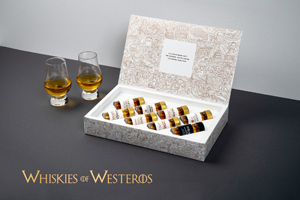
Attractively designed and perfectly matched to the tonality of Game of Thrones: The sampling set Whiskies of Westeros.
The beverage manufacturer Diageo demonstrated in a product partnership with HBO for the spectacular final of Game of Thrones that the merchandise can also be high-proof. The distillery used the magical attraction of the epic for the Game of Thrones inspired Single Malt Scotch Whisky Collection that was created especially for the series. Seven of the eight bottles of whisky were designed with the respective coat of arms of one of the seven kingdoms of Westeros, the spirits manufacturer also selected the brands of single malt whisky accordingly. For example, the lion coat of arms of the powerful Lannister royal family graces the most expensive whisky of the line-up, a nine-year-old Lagavulin. The eighth whisky is dedicated to the Night’s Watch of Westeros and is thus styled totally in black just like the robes of the Night’s Watch. In Germany, the beverage provider Tastillery additionally presented the whiskies as a Whiskies of Westeros set in small sampling bottles à 30 ml, “so that the whiskies are drunk and don’t just stand around on a shelf,” as the Tastillery Managing Director, Waldemar Wegelin, commented. “The whiskies inspired by Game of Thrones are designed accordingly, the contents are perfect aligned with the tonality of the series and quickly advance into becoming collector’s items. Our sets that were limited down to 500 pieces were sold out in no time at all and were in some cases auctioned off on eBay at much higher prices.”
Dabrowski is also aware of the appeal of the current hit series. Goldenberry has been working together with HBO for several years and has developed and implemented among others a wide selection of merchandising items for Game of Thrones – including the related logistics. “Of course, we also supply classics such as T-shirts or umbrellas for series, but particularly when a longawaited new series comes out, outstanding products with a wow effect have to be created for the corresponding launch events, press conferences and meetings. For the VIP customers of HBO, we imported among others Game of Thrones whisky all the way from England,” stated Dabrowski.
Teasers and touchpoints
Bridging the time gap between the individual seasons is a decisive part of the customer loyalty strategy of HBO and Co. Using exciting, original contents, cross-season storylines and their own, true-to-detail look, the series turn viewers into fans. Campaigns and products on the show keep the fans in good spirits – like a campaign orchestrated by the Berlin-based agency, Heimat Active, for the Netflix Original Money Heist. The red overalls and Dali masks as well as the aliases of the characters – they only know each other under the names of cities like Berlin, Denver, Nairobi or Tokyo – are typical for the series that was launched in 2017. For the start of the third season in July 2019, Heimat Active packed ten large, red suitcases. Crammed full with (fake) 50 Euro notes and bearing the (city) names of the characters, they circled round and round on the conveyor belts at Frankfurt Airport. As Viktoria Zielinski, Account Director at Heimat Active commented: “As a literally tangible marketing tool, the suitcases became part of the story and aroused huge desire among the fans. Some of the cases did actually disappear, because people took them – this made them feel like they were members of the Money Heist gang.”
The Polish fans of Game of Thrones also developed criminal energy: “We produced for instance notebooks with a special cover design inspired by Game of Thrones, in this way a simple item becomes an absolute musthave for fans. Our supplier partner reported that they had to install surveillance cameras in the production hall so that the books didn’t disappear from the conveyor belt,” commented Dabrowski. “As soon as an item carries the motif of a series, it becomes relevant for fans. The great popularity of the series and the accompanying products as well as the huge selection of formats and fan communities makes the SVOD market very interesting for us and the promotional products industry in general. Collaborating with producers like HBO, who mostly operate and market items on a trans-national level, is worthwhile for internationally-operating promotional products agencies. Of course, great importance has to be attributed to the creative product development and to the in some cases different demands of the regional markets.”
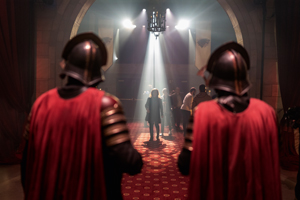
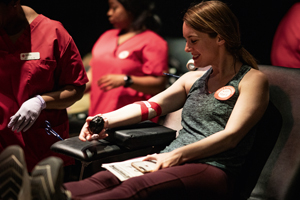
Because haptic messengers can be integrated into the environment of series in multiple or indeed spectacular ways in the scope of promotions and campaigns, there is a lot of creative leeway. At the SXSW Festival in 2019 for example, the visitors were able to become immersed in the world of their favourite series: The producers of HBO had organised an event focusing on the final season of Game of Thrones – diverse audio-visual stations, based on storylines of the main characters such as Arya Stark or Cersei Lannister. In the reproduced throne room, the participants received a “Hand of the King” badge, which activated discounts at the festival. Furthermore, following the moMontto “Bleed for the Throne”, a blood donating zone of the American Red Cross awaited volunteers, who – in line with the show steeped in violence – literally did have to bleed to win an Iron Throne. Consolation prizes included posters of the heroes of the series signed by the stars. Dabrowski is convinced that picking up on the specific atmosphere of a series and reflecting this in the product is decisive: “We designed a set for the successful Polish series Wataha about a unit of border police officers at the Polish- Ukrainian border, which perfectly united the rugged military look and the omnipresent alcohol consumption in the series: A metal case for hand grenades from the Soviet times, filled with regional spirits.”
To be continued
An essential part of the briefing for campaigns for series is the extension on the web – haptic advertising plays a role here too. In this way, fans of the “Bleed for the Throne” campaign were able to post what they would do for the Iron Throne under the hashtag #Forthethrone. In the scope of the Money Heist campaign on the other hand, huge posters placed in big cities provoked plenty of discussion across the social media beyond the suitcase campaign and produced a contentrelated association with a high recognition level, which according to Zielinski fuelled the theories circulating around the fan community. For the marketing expert there is a clear difference between this and a pure advertising campaign, because “in series marketing it is about playing with the contents and offering the fans added value. We wanted to continue the story of this popular, keenly awaited show.” Stacy Jones also stressed the significance of relevant contents and good storytelling: “Producers like to work with agencies and brands who think outside the box and pick on the storylines in a clever way that’s also typically very social. Thus, campaigns can easily be spread via social media to create more buzz across the international fan base.” Goldenberry places contents and products related to series even on their own behalf in the social media: “Our good relationship to HBO also enables us to implement the merchandising items for our own prize draws. This allows us to obtain thousands of reactions across our channels within a few days – the fans snap up the products. This in turn clearly shows us the magnitude of the interest in the series landscape and how easily the target audience can be impressed with corresponding motifs,” stated Dabrowski.
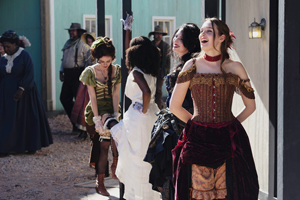
Real wild west atmosphere awaited the guests of the festival event SXSWestworld: HBO had the fictitious Western town of Sweetwater rebuilt as an interactive promotion for the coming start of the second season. Before diving into the experience, fans could choose their own cowboy hat – white for the honest guests and black for the villains.
According to Jones, what worked very well both in terms of the products and the communications, was the Burger King campaign for Stranger Things: “The brand had a natural tie-in with a store in one of the main settings of the show, the Starcourt Mall. The Upside Down Whopper, a flipped burger in special packaging they launched for the show, was simple yet effective – a well-orchestrated, organic partnership, also in social media. The New Coke campaign was a bit much, though. Brands have to find the right balance for their storytelling,” Jones added. Coca-Cola relaunched New Coke for the third season – a variety introduced in 1985 with a new look and taste that was supposed to replace the classic soft drink. After strong criticism the new recipe disappeared into the product archive of the beverage manufacturers after a few months, where it was retrieved from again in 2019 especially for Stranger Things and reproduced as a limited edition. “A good idea, yet the ever-present product placement, which even included the actors talking about the flavour of New Coke on the show, was over the top and didn’t go down well with the viewers.” The target group-specific address of the respective fan community is one of the most important aspects for the merchandise experts from Elbenwald with good reason: “Our aim is to put together a product range for the fans for their favourite fandom, which is high-quality and original – a selection that lives up to the fan’s eye,” stated Gräber.
Whereby the creation of a merchandising collection or campaign is extremely time-consuming. “Some orders are processed quickly, because we only have to customise the standard products of our supplier partners with an imprint or embroidery. In other cases, more effort is involved – here for instance we first have to find suppliers, among others for specific, regional products like culinary items or spirits. This takes a lot more time. Furthermore, we have to always keep a close eye on the correct, high-quality implementation of motifs that are copyright protected,” confirmed Dabrowski. “Maintaining a partnership with the series producers is nevertheless still worthwhile for us. The orders are extremely prestigious and good for our image as service providers of professional promotional products.” Especially when haptic advertising ultimately plays a major role – as with the cowboy hats in the Western experience of SXSWestworld: The long-awaited start of the series was brought closer using a true-to-detail staged experience, which transported the fans into the series, offered them content-related added value in the form of hidden clues about the plot as well as providing them with a haptic gift perfectly aligned with the contents in the form of a high-quality hat. The gain for HBO: 1.9 billion media impressions and the feedback from the visitors of having “delivered one of the best publicity stunts of the 21st Century”.
// Claudia Pfeifer
Photos: Jens Friedrich (1), Thomas Gebhard (1), © WA Media; Baskin-Robbins (1); HBO (3); Tastillery (1)





